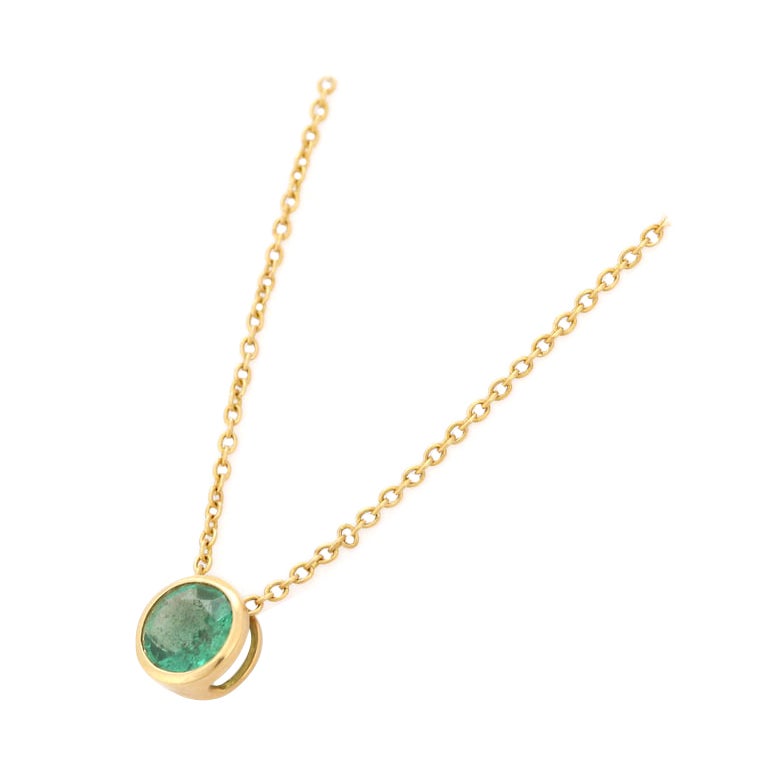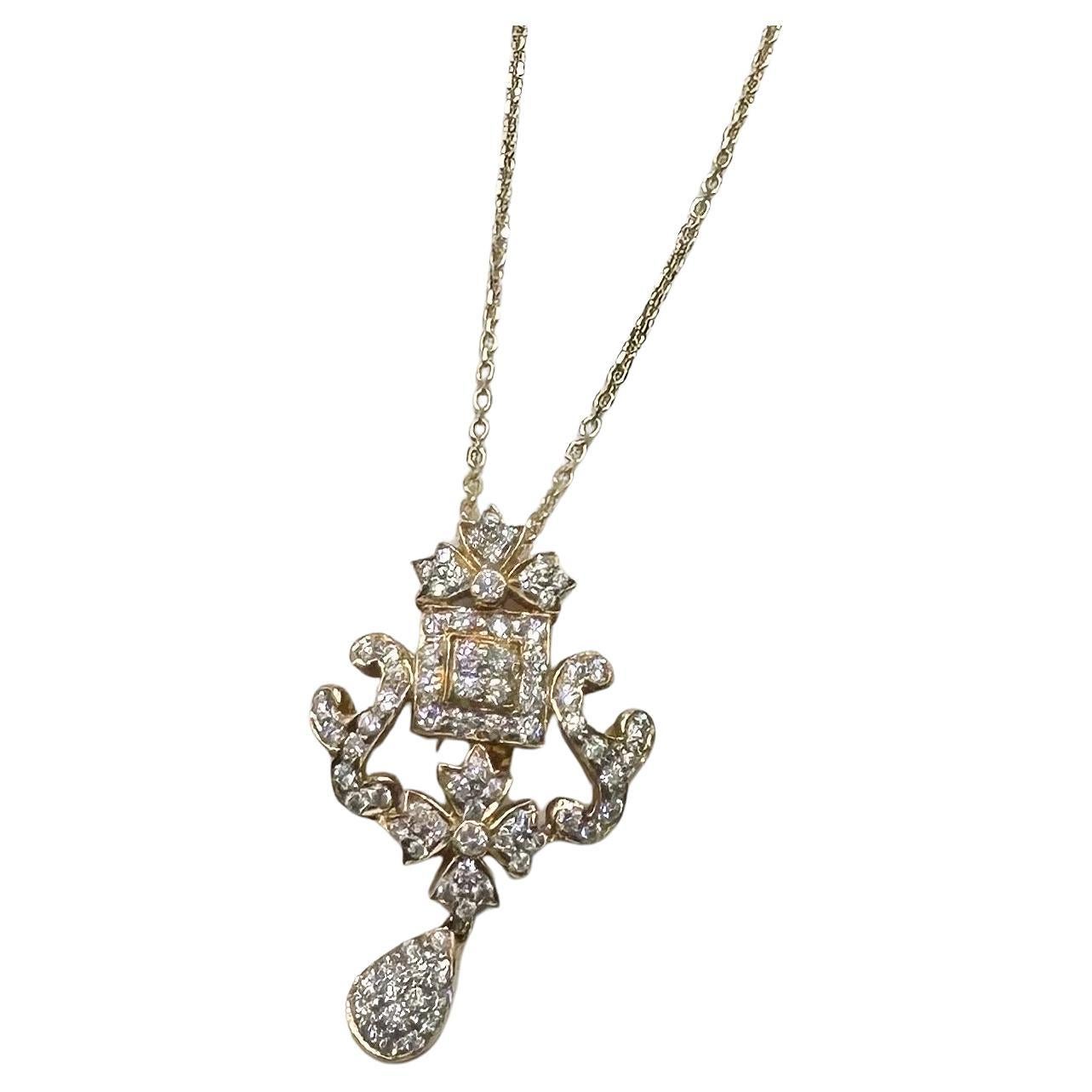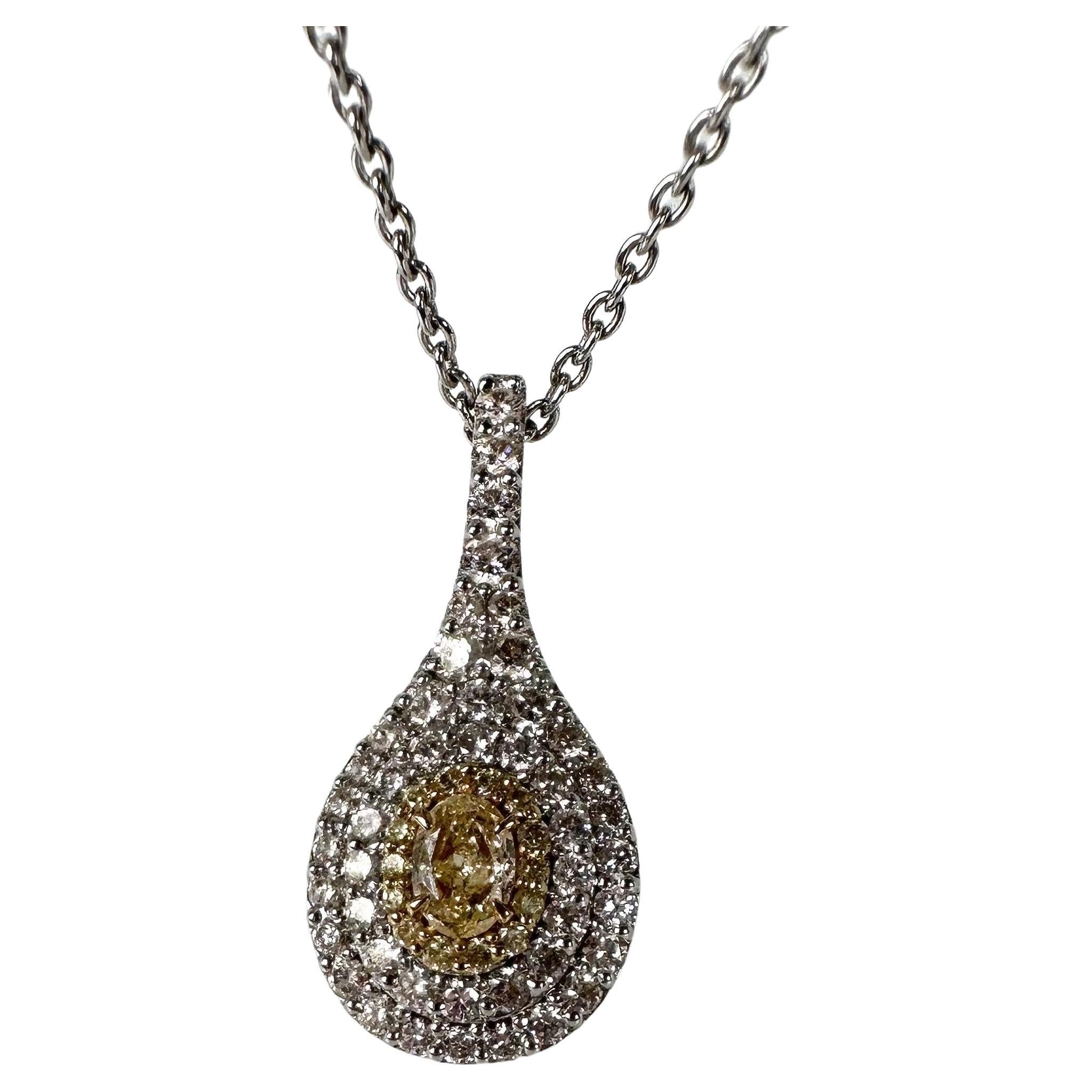Items Similar to Liuba Wolf 1970 Concretism Sculptural Pendant Necklace Chain In 18Kt Yellow Gold
Want more images or videos?
Request additional images or videos from the seller
1 of 11
Liuba Wolf 1970 Concretism Sculptural Pendant Necklace Chain In 18Kt Yellow Gold
About the Item
Sculptural necklace designed by Liuba Wolf.
Extremely rare sculptural necklace, created in Sao Paulo Brazil by the artist Liuba Wolf, back in the 1970. This fantastic piece is a one of a kind and has been crafted with concretism art patterns in solid rich yellow of of 18 karats with textured surfaces. The main pendant is completely chiseled with irregular hammered finishes and sharp edges It is fitted with a removable chain in suite, which is composed of twenty six geometric links of different lenght and a security hook lock.
Weight: 108.52 Grams, (69.57 Dwt).
Size: The lenght of the chain is 25 Inches, (63.5 Cm).
Measurements: The main sculpture pendant is 55 mm by 71 mm by 10 mm (2.16 x 2.79 0.39 Inches).
Hallmarks: Stamped with the designer artist name, the mark for the assay of the gold, the edition number and signed, "LIUBA .750 1/30 1/50".
Edition: Brazil Sao Paulo 1/30 for the pendant and 1/50 for the geometric chain, the authorized edition was only of 30 and 50 pieces, respectively but the production was never completed and only the number 1 of each one was made. Both pieces are stamped with the edition numbers.
Liuba Wolf
She born as Liuba Boyadjieva in Sofia Bulgaria in 1923. She was raised in a privileged, cultivated milieu by a writer mother and industrialist father who (he also played the violin) instilled in her a taste for music. The artist received a humanistic education, studying Greek and Latin and mastering the piano. When her family moved to Geneva, she attended art school and developed a special interest in sculpture. Later, she studied in Zurich under Germaine Richier (1904-1958), a renowned artist of the Paris School.
This contact with Germaine Richier had a strong impact on Liuba Boyadjieva’s education as a modern sculpture and left a deep imprint on her understanding of sculpture. In those years, in Zurich, she was also in contact with a group of important artists, like, among others, Marino Marini and Arthur Honnegger. At the end of the war, when Richier reopened her atelier in Paris, Liuba moved to the French capital and continued her studies with her teacher until 1949. Her social circle in France included Zadkine, Viera da Silva, Alberto Magnelli, among others. She traveled often throughout Europe and visited the most important museums. Liuba Boyadjieva came to Brazil, married the industrialist and collector Ernesto Wolf in 1958, and lived between São Paulo and Paris, keeping studios in both cities. She became a naturalized Brazilian citizen. She developed a personal way of working her sculptures and achieved full artistic maturity. In the 1960s and 1970s, Liuba Wolf exhibited her work in several cities around the world and achieved international recognition. In 2001, on the occasion of her exhibition at Achim Moeller Fine Art. Rizzoli (New York) published a book celebrating Wolf’s art and featuring Sam Hunter’s essay “Liuba: At the Edge of Abstraction.” Among the central features of Liuba Wolf’s work are her expressive power, the surface’s play between the smooth and the textured, and rusticity. Verticality is another key characteristic, as well as the gesturalism of the forms. Figurative early on in her career, Wolf’s works became abstracted starting in the 1950s, but there always remained an archaic memory that referred back to primitive archetypes. Some critics, like Sam Hunter, see in those shapes a reference to pre-Columbian realities. Another highlight is a degree of surrealism in Wolf’s abstraction, yet critics mostly underscore the fact that she situated her sculptures at the border between abstraction and figuration, as well as the force of imagination in the conception of the works. On more than one occasion Liuba Wolf said that her forms are born from the subconscious. For her, they are “bugs”, animals, but they can also be plants or roots. They could be totems, in a symbiosis between the animal and the plant worlds, according to another observer, artist Emmanoel Araújo. Liuba Wolf stated once in an interview that her work “finds inspiration in natural shapes.” The exhibition at the Lasar Segall Museum made it possible for visitors to reengage with Liuba Wolf’s sculpture, revitalizing the aesthetic dynamics it prompts in its viewers. Curators Jorge Schwartz and Marcelo Monzani selected twenty-seven works for exhibition, and situated Liuba Wolf as one of Brazil’s most important female sculptures, alongside María Martins, Felícia Leirner, Sonia Ebling, and Pola Resende. (Moeller fine art with thanks).
Concrete Art
This term, was coined in 1930 by Theo Van Doesburg in his manifesto "Concrete Art", written in response to the formation of the association "Cercle et Carré". The document was signed by Hélion, Carlsund, Tutundjian and Wantz. When Van Doesburg died in 1931, his ideas were taken up at the end of the 1930s by two Swiss artists, Max Bill and Jean Arp, who published several works and held important exhibitions of painting, sculpture and applied arts. The denomination "concrete" or "concretism" is assumed in Switzerland in the post-war period by artists working in the current of geometric abstraction. The relationship between abstraction and concrete art is evident in the exhibition at the René Drouin Gallery in Paris in 1945, since it is the first important exhibition of abstract art, and its title was precisely “Art Concret”. In this art all kinds of illusionism are excluded; the work and the elements of which it consists are presented strictly for what they are, without virtual qualities. Materials do not simulate anything other than themselves. The slogan “real materials, real space” is often used in relation to this art form.
Literature: Rizzoli, New York 2001, “Liuba: At the Edge of Abstraction.”. published book celebrating Wolf’s art and featuring Sam Hunter’s essay. For similar large sculptures illustrated.
Note: We are offering in our other listing, the clip on earrings in suite to this necklace.
Collateral: It is accompanied by a presentation jewelry box.
Condition: The overall condition of this necklace is excellent. Beside the little normal wear, there is no damage to the gold. All parts are secured in the settings. This necklace has been carefully inspected to guarantee the condition and authenticity.
INVENTORY REF: N111723RTAR/2.608
- Creator:Liuba Wolf
- Metal:
- Weight:108.52 g
- Dimensions:Height: 2.59 in (65.79 mm)Width: 2.16 in (54.87 mm)Depth: 0.39 in (9.91 mm)Length: 25 in (635 mm)
- Sold As:Set of 2
- Style:
- Place of Origin:
- Period:
- Date of Manufacture:1969
- Condition:Wear consistent with age and use. The overall condition of this necklace is excellent. Beside the little normal wear, there is no damage to the gold. All parts are secured in the settings. This necklace has been carefully inspected to guarantee the condition and authenticity.
- Seller Location:Miami, FL
- Reference Number:
About the Seller
4.9
Recognized Seller
These prestigious sellers are industry leaders and represent the highest echelon for item quality and design.
Platinum Seller
These expertly vetted sellers are 1stDibs' most experienced sellers and are rated highest by our customers.
Established in 1995
1stDibs seller since 2022
420 sales on 1stDibs
Typical response time: <1 hour
- ShippingRetrieving quote...Ships From: Miami, FL
- Return PolicyA return for this item may be initiated within 1 day of delivery.
More From This SellerView All
- Liuba Wolf 1970 Sao Paulo Concretism Sculptural Earrings In 18Kt Yellow GoldLocated in Miami, FLSculptural clip earrings designed by Liuba Wolf. Extremely rare sculptural clips on earrings, created in Sao Paulo Brazil by the artist Liuba Wolf, back in the 1970. This fantastic pair is a one of a kind and has been crafted with concretism art patterns in solid rich yellow of of 18 karats with textured surfaces. The figurative pieces are completely chiseled with irregular finishes and sharp edges Designed as a left and right pair and fitted with posts for pierced ears and comfortable omega backs for fastening clips. Weight: 18.30 Grams, (11.73 Dwt). Measurements: 18 mm by 15 mm (0.71 x 0.59 Inches). Hallmarks: Stamped with the designer artist name, the mark for the assay of the gold, the edition number and signed, "LIUBA .750 1/30". Edition: Brazil Sao Paulo 1/30, the authorized edition was only of 30 but the production was never completed and only the number 1 was made. Liuba Wolf She born as Liuba Boyadjieva in Sofia Bulgaria in 1923. She was raised in a privileged, cultivated milieu by a writer mother and industrialist father who (he also played the violin) instilled in her a taste for music. The artist received a humanistic education, studying Greek and Latin and mastering the piano. When her family moved to Geneva, she attended art school and developed a special interest in sculpture. Later, she studied in Zurich under Germaine Richier (1904-1958), a renowned artist of the Paris School. This contact with Germaine Richier had a strong impact on Liuba Boyadjieva’s education as a modern sculpture and left a deep imprint on her understanding of sculpture. In those years, in Zurich, she was also in contact with a group of important artists, like, among others, Marino Marini and Arthur Honnegger. At the end of the war, when Richier reopened her atelier in Paris, Liuba moved to the French capital and continued her studies with her teacher until 1949. Her social circle in France included Zadkine, Viera da Silva, Alberto Magnelli, among others. She traveled often throughout Europe and visited the most important museums. Liuba Boyadjieva came to Brazil, married the industrialist and collector Ernesto Wolf in 1958, and lived between São Paulo and Paris, keeping studios in both cities. She became a naturalized Brazilian citizen. She developed a personal way of working her sculptures and achieved full artistic maturity. In the 1960s and 1970s, Liuba Wolf exhibited her work in several cities around the world and achieved international recognition. In 2001, on the occasion of her exhibition at Achim Moeller Fine Art. Rizzoli (New York) published a book celebrating Wolf’s art and featuring Sam Hunter’s essay “Liuba: At the Edge of Abstraction.” Among the central features of Liuba Wolf’s work are her expressive power, the surface’s play between the smooth and the textured, and rusticity. Verticality is another key characteristic, as well as the gesturalism of the forms. Figurative early on in her career, Wolf’s works became abstracted starting in the 1950s, but there always remained an archaic memory that referred back to primitive archetypes. Some critics, like Sam Hunter, see in those shapes a reference to pre-Columbian realities. Another highlight is a degree of surrealism in Wolf’s abstraction, yet critics mostly underscore the fact that she situated her sculptures at the border between abstraction and figuration, as well as the force of imagination in the conception of the works. On more than one occasion Liuba Wolf said that her forms are born from the subconscious. For her, they are “bugs”, animals, but they can also be plants or roots. They could be totems, in a symbiosis between the animal and the plant worlds, according to another observer, artist Emmanoel Araújo. Liuba Wolf stated once in an interview that her work “finds inspiration in natural shapes.” The exhibition at the Lasar Segall...Category
Vintage 1960s Brazilian Modernist Clip-on Earrings
MaterialsGold, 18k Gold, Yellow Gold
- Giorgio Facchini Sculptural Kinetic Orbital Necklace In 18Kt Yellow GoldBy Giorgio FacchiniLocated in Miami, FLOrbital necklace designed by Giorgio Facchini (Pesaro 1947-). Fabulous statement collar necklace, created by the Italian master jeweler, artist and sculptor, Giorgio Facchini. This ...Category
1990s Italian Modernist Pendant Necklaces
MaterialsGold, 18k Gold, Yellow Gold
- Cartier Paris 1994 Rare Necklace Pendant In 18Kt Yellow Gold With MalachiteBy CartierLocated in Miami, FLMalachite necklace pendant designed by Cartier. This is a very rare and very hard to find necklace-pendant, created in Paris France by the jewelry house of Cartier. It was carefully...Category
1990s French Modern Pendant Necklaces
MaterialsMalachite, Gold, 18k Gold, Yellow Gold
- Bauhaus Germany 1970 Modernist Pendant Brooch in 18Kt Yellow Gold and SteelLocated in Miami, FLA modernist Bauhaus studio pendant-brooch. Interesting modernist vintage piece, created around the 1970'S in northern Europe, probably Germany, Austria or Switzerland. This art-pie...Category
Vintage 1970s German Modernist Brooches
Materials18k Gold, Yellow Gold, Steel
- Italian 1970 Modernist Long Necklace Chain In Solid 18Kt Yellow GoldLocated in Miami, FLAn Italian modernist chain A beautiful modernist chain, created in Italy back in the 1970. This vintage long chain has been crafted with eighty-...Category
Vintage 1970s Italian Modern Link Necklaces
MaterialsGold, 18k Gold, Yellow Gold
- Tiffany Co. 1970 by Elsa Peretti Chain Necklace in 18kt Gold with Carved NephritBy Elsa Peretti for Tiffany & Co.Located in Miami, FLRare nephrite heart necklace by Elsa Peretti (1940-2021) for Tiffany & Co. An unusual vintage piece designed by Elsa Peretti, back in the 1970's. It was created at the Tiffany Stud...Category
Vintage 1970s American Modernist Pendant Necklaces
MaterialsJade, Gold, 18k Gold, Yellow Gold
You May Also Like
- Emerald Pendant in 18kt Solid Yellow Gold with ChainBy VR JewelsLocated in Houston, TXElegant Emerald Chain Necklace in 18K Gold studded with round cut emerald. This stunning piece of jewelry instantly elevates a casual look or dressy outfit. Emerald enhances the intellectual capacity. Designed with round cut emerald studded in solid gold making a stunning dainty charm. This beautiful handcrafted necklace is a great piece of jewelry for wedding gift or anniversary gift or graduation gift...Category
21st Century and Contemporary American Modern Pendant Necklaces
MaterialsEmerald, 18k Gold, Gold, Yellow Gold
- 1ct Vintage diamond pendant necklace 18KT yellow gold chain 18"Located in Boca Raton, FLElegant pendant necklace made with 1ct of natural diamonds in 18KT yellow gold. Metal Type: 18KT Natural Diamond(s): Color: F-G Cut:Round Brilliant Carat: 1ct Clarity: VS-SI Cer...Category
21st Century and Contemporary Pendant Necklaces
MaterialsDiamond, 18k Gold, Yellow Gold
- Fancy Yellow Diamond pendant necklace 18KT white gold 18" chainLocated in Jupiter, FLFancy yellow diamond pendant necklace in 18KT white gold, stunning classical pendant that will complement any outfit! GOLD: 18KT gold NAT...Category
21st Century and Contemporary Pendant Necklaces
- Starfish pendant necklace 18Kt yellow goldLocated in Jupiter, FLGlass enamel in a unique presentation and design, using array of colors that will never fade. METAL: 18KT yellow gold Grams:2 Item: 43500010kat Chain included WHAT YOU GET AT STAMP...Category
21st Century and Contemporary Pendant Necklaces
- 18kt Yellow Gold Chain CrossLocated in Esch-Sur-Alzette, LUThis cross is particular and stands out from the others thanks to its shape. The design represents a small chain that forms a cross. This pendant is in excellent condition and shows ...Category
Late 20th Century Swiss Contemporary Pendant Necklaces
MaterialsYellow Gold
- The 1.50 Carat White Lozenge Pendant, 18kt Yellow Gold with 18kt ChainBy LeBlanc JewelleryLocated in Stoke-On-Trent, GBThe Lozenge (derived from the French word losange) is a classic symbol of clarity and wisdom. The delicate charm’s four equal in length sides represent the task of balancing inner po...Category
2010s European Modern Pendant Necklaces
MaterialsYellow Gold, 18k Gold
Recently Viewed
View AllMore Ways To Browse
Vintage Ruby Cross
Tanzanite Slide
Dior Triangle Necklace
Vintage E Initial Gold Diamond
Faberge Blue Enamel Cross
Garnet Lavalier
Gold Chain With Charm Clasp
Emerald Love Heart
Edwardian Platinum Diamond Pendant
Celestial Sun
Tiffany Silver Heart Jewelry
Diamond Bee Pendant
White Gold Teardrop Pendant
Spring Charm Clasp
Vintage Sapphire Platinum Necklace
Guilloche Orange
Type A Burmese Jadeite
65ct Diamond Necklace





